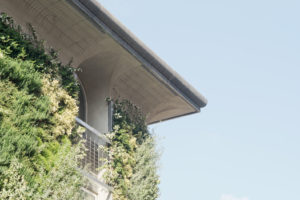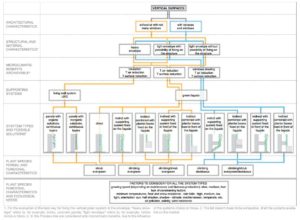
Vertical greening
Contemporary architecture is increasingly focusing on vertical greening systems as a means to restore the environmental integrity of urban areas, biodiversity and sustainability. Vertical greening is the activity of greening the building envelope with all forms of vegetated wall surfaces (www.greenroofs.org) as with plants either rooted into the ground, in the wall itself or in modular panels attached to the façade. Vertical green can be classified as façade greening or living wall systems according to the growing method employed. The plant choice affects the aesthetical and functional aspects of a greened façade and many parameters have to be taken into account when choosing plant species for vertical greening systems. These parameters include the supporting system type, microclimatic benefits, maintenance needs, biomass production, climate type, and environmental parameters, façade orientation and constraints within the urban area.
Contemporary architecture is increasingly focusing on vertical greening systems as a means to restore the environmental integrity of urban areas, biodiversity and sustainability.
Benefits of vertical greening systems
Applying vertical greening systems on both new and existing buildings can offer multiple environmental benefits and a sustainable approach in terms of energy saving, nutrients and water management and efficient preservation of edifices.
The ecological and environmental benefits of green roofs include the improvement of air quality, the reduction of pollution, increased biodiversity and reduction of the heat island effect in urban areas. Plant’s leaves collect and absorb fine dust particles and transform the carbon dioxide produced by traffic & heating into carbon hydrates and oxygen. The reduction of the heat island effect in urban areas occurs thanks to the lower amount of heat re-radiated by greened façades and humidity affected by the evapostranspiration caused by plants as compared to artificial surfaces. This process also allows indirectly saving considerable energy supplied to the building as the plants and the growing medium provide insulation and shade which can reduce energy needed for cooling, especially in the Mediterranean area.

Vertical greening systems can improve biodiversity as they create a habitat for microorganisms and also for smaller animals such as bees, bats, birds, etc. Green façades function in this context as a food source (insects) and as nesting or breeding opportunity.
Besides the above-mentioned benefits, green roofs and walls also provide economic advantages. Those relate to the real estate market, greater durability of buildings, and a better psychological state of citizens.
The presence of vegetation in urban areas might affect the economic value of buildings, increase property or rental prices due to the improved aesthetic aspects. Both green roofs and vertical greening systems reduce the frequency of maintenance interventions thanks to a protective action of leaves against negative effects of UV rays, temperature fluctuations, acid rain and air pollution on the underlying surfaces.
Still, vegetation and green areas are scarce in contemporary urban environments, where impervious surfaces i.e. traditional building materials, asphalt roads, etc. may cover more than 75% of the total area. It’s advisable that most of the cities’ surfaces are green because some of the environmental benefits of greening the building envelope only work if a large surface in the given area is greened.
Our research and the process tree
My research focuses on the effects of vertical greening systems on the building energy performance and in particular on ways to reduce the energy demand for air conditioning. I consider environmental and economic suitability and sustainability of various vertical greening systems because it appears that some vertical greening systems are more sustainable than others from an economic and environmental perspective.
To provide a full perspective on vertical greening systems, I and my co-workers have developed a process tree.
The greening systems’ design needs to take into account many aspects including the integration with the building envelope, a sustainable material choice, the environmental impact, and the symbiosis between the growing medium and the vegetation, the economics related to costs and potential savings due to possible reduction of energy needed for heating and cooling. To provide a full perspective on vertical greening systems, I and my co-workers have developed a process tree. Our process tree makes it possible to incorporate and analyze the main parameters of vertical greening systems and to compare various climate and building characteristics such as technologies, materials, durability, dimensions, and plant species employed in the design process. Our aim is to increase our understanding of vertical greening systems, to promote their use, to make their application possible and to help avoiding damages and maintenance problems caused by inappropriate design.

Our next steps
More research is needed to quantify all the environmental benefits of vertical greening systems, especially air quality improvement and cooling capacity. For this reason, we, the Ecosystemics research group of the Polytechnic School of the University of Genoa, Architecture and Design Department, built a pilot project in Italy, the first green wall built in the city of Genova. A broad research project is focused on the monitoring of the National Institute of Social Insurance (INPS) Green Façade pilot project, which includes the analysis of environmental, economic and social benefits in the context of densely urbanized areas, especially those in the Mediterranean region.
Read full article: Vertical greening systems, a process tree for green façades and living walls